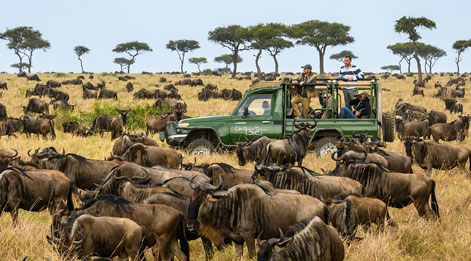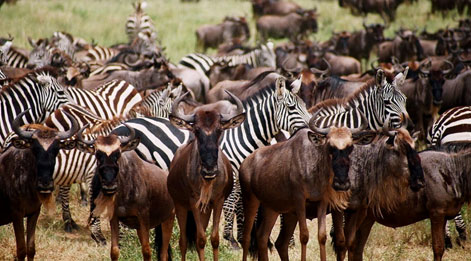Great Migration in African National Parks
The Great Migration is a remarkable phenomenon, involving the circular movement of over a million animals across the Serengeti-Mara ecosystem. This migration includes columns of wildebeest accompanied by various companions such as Burchell’s zebras, antelopes, and other herds. Annually, this journey spans from Serengeti National Park in Tanzania to Masai Mara National Reserve in Kenya, navigating crocodile-infested water bodies and terrestrial predators like lions and leopards along the route. For wildlife enthusiasts, witnessing the Great Migration is a top priority, as it offers a truly unparalleled experience.
East Africa's Great Migration stands as the largest terrestrial mammal migration globally, characterized by its treacherous nature. During this migration, animals must not only search for sustenance but also give birth to future generations to ensure the continuity of the migration. It's a testament to the enduring struggle for survival, showcasing some of Africa's most magnificent and resilient creatures.


The Circle of the Great Migration
Although commonly labeled as an annual event, the Great Migration is actually a continuous and dynamic year-long journey undertaken by animals traversing through Tanzania and Kenya. Originating in Tanzania’s Serengeti National Park and extending northward into Kenya’s Maasai Mara Game Reserve, this migratory route spans approximately 2,900 km, following a clockwise circle. The journey transitions from the southeast grasslands to the northwest woodlands and back again, encompassing various dramatic river crossings along the way. However, these crossings represent only a fraction of the migration's intricate series of events that unfold across two different countries throughout the seasons. These events include mating rituals, calving, and the herd's shifting fortunes, all of which are influenced by subtle yearly changes in rainfall patterns.
The migration commences in the southern Serengeti during the birthing season of wildebeest calves. As drought sets in around May, the herd migrates northward toward Kenya's Msasai Mara, grazing on the lush green grasslands, accompanied by gazelles and zebras. This journey is fraught with risks, as river crossings entail encounters with crocodiles patiently awaiting their prey, alongside the formidable Serengeti lion population, the largest in Africa.
With the onset of short rains in October, the migration retraces its path back to the Serengeti. By December, the herds pass through Seronera, a small settlement in central Serengeti, before returning to their calving grounds, thus completing the cycle.
Best Time and Location to Witness the Great Migration
An expertly crafted safari in East Africa, encompassing Kenya, Tanzania, or both regions, offers the ultimate opportunity to witness the Great Migration in all its splendour.
• December to July in Serengeti National Park
From December to early March, the herds predominantly inhabit the southern region of the Serengeti in Southern Tanzania. This area is favoured for calving due to its nutrient-rich soil and grass, stemming from volcanic eruptions millions of years ago, providing the calves with the richest milk. Wildebeests prefer this region for calving as it offers protection from predators that typically hide in taller grass.
As April approaches, the long rainy season begins. The herds commence their migration northward, traversing the central and western Serengeti, feeding themselves voraciously along the way. By April, the Serengeti begins to dry up, prompting the herds to follow the Grumeti River westward.
Throughout June and July, the herds continue their journey through the western corridor of the Serengeti, advancing northward toward the Masai Mara. During June, the Grumeti River's water level decreases, often leaving behind crocodile-infested pools as the sole water source, with both wildebeests and zebras consuming nearly three gallons daily. By July, the herds reach the northern reaches of Tanzania, near the border with Kenya. During this period, they also hasten their migration toward the Masai Mara as the reserve receives rainfall from Lake Victoria.
• August to September in Masai Mara Game Reserve
By August, a significant portion of the migration typically reaches Masai Mara, culminating in dramatic river crossings at the Mara and Talek rivers. This month is considered perfect for witnessing these crossings in action, as hungry crocodiles eagerly await their prey.
As October passes, the herds commence their departure from the Mara, in November, turning southward in search of greener pastures as they begin their journey back to the Serengeti for the onset of Tanzania's rainy season. By early October, the grasslands of Masai Mara become nearly barren. The massive migration, consisting of millions of animals, embarks on its southward trek, consuming approximately 5,000 tons of grass daily along the way.
Month-wise Location of the Great Migration Cycle in East Africa
| Months | December - March | April | May - June | July - October | November |
| Areas | Northern Ngorongoro Conservation Area and Southern Serengeti | Central Serengeti | Western Serengeti | Northern Serengeti and Masai Mara | Eastern and Central Serengeti |
| Experience | Calving Season | Trekking to North | Rutting Season | River Crossings | Trekking to South |


